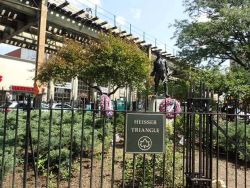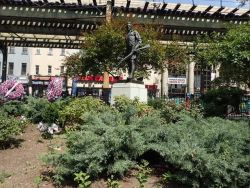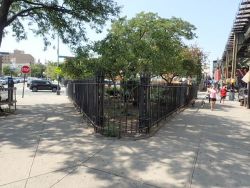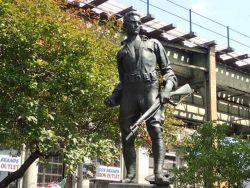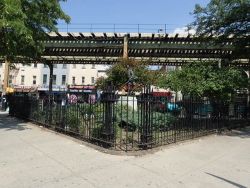Heisser Triangle
Heisser Triangle
This Bushwick triangle, located at the intersection of Knickerbocker Avenue, Myrtle Avenue and Bleecker Street, was named for Charles Heisser, a young man who lived two blocks from here at 297 Grove Street. Heisser, a World War I sergeant in the Headquarters Company, 106th Infantry, was killed in action in France on September 27, 1918.
The city acquired this Bushwick parkland by condemnation in 1905, and it was transferred to Parks through the Sinking Fund in 1921. One of the original six towns of Brooklyn, Bushwick comes from the Dutch word Boswijck, meaning “refuge in the woods” or “heavy woods.” Chartered by Peter Stuyvesant in 1661, Bushwick was settled in the 19th century by tobacco and grain farmers from France, Scandinavia, England, and Holland. By the mid-1800s, Bushwick boasted 11 breweries on a 14-block stretch known as “Brewer’s Row.” Manufacturer and onetime presidential candidate Peter Cooper built his first glue manufacturing factory here in the 1840s, joining the sugar, chemical, and oil industries. The subdivision of farms begun by Adrian Martenses Suydam in 1869 led to a population growth that gained even more momentum after 1888, when railway access made commuting to Manhattan easy and living in Bushwick increasingly attractive to professionals.
The bronze war memorial at the center of the plot was sculpted by Pietro Montana (1890-1978) in 1921. Born in 1890 in Alcamo, Italy, Montana became a United States citizen and studied at Cooper Union and the Mechanics’ Institute. The statue of a doughboy bearing a rifle in one hand and a clenched fist in another honors the 156 young men from this neighborhood who served in World War I. On the base, designed by architect Giles Greene Pollard, is a plaque reading “To the memory of the Bushwick-Ridgewood boys who served in the World War 1917-1918.” A cement plaque on the ground next to the statue is engraved with the date, November 11, 1920. An World War I cannon once stood here, flanked on either side by tall flagpoles. Many other parks in the city once included similar weaponry in their war memorials, but only eight such guns remain. The rest, like this one, were melted for scrap metal in World War II to make new arms.
Heisser Triangle, covered with marigolds, bluebells and bushes, is a welcome grassy oasis in the midst of several busy thoroughfares. Named by resolution of the Board of Aldermen in 1920, this parkland serves as a patriotic tribute to a brave young man who made the ultimate sacrifice for his country.
Check out your park's Vital Signs
Clean & Safe
Green & Resilient
Empowered & Engaged Users
Share your feedback or learn more about how this park is part of a
Vital Park System

